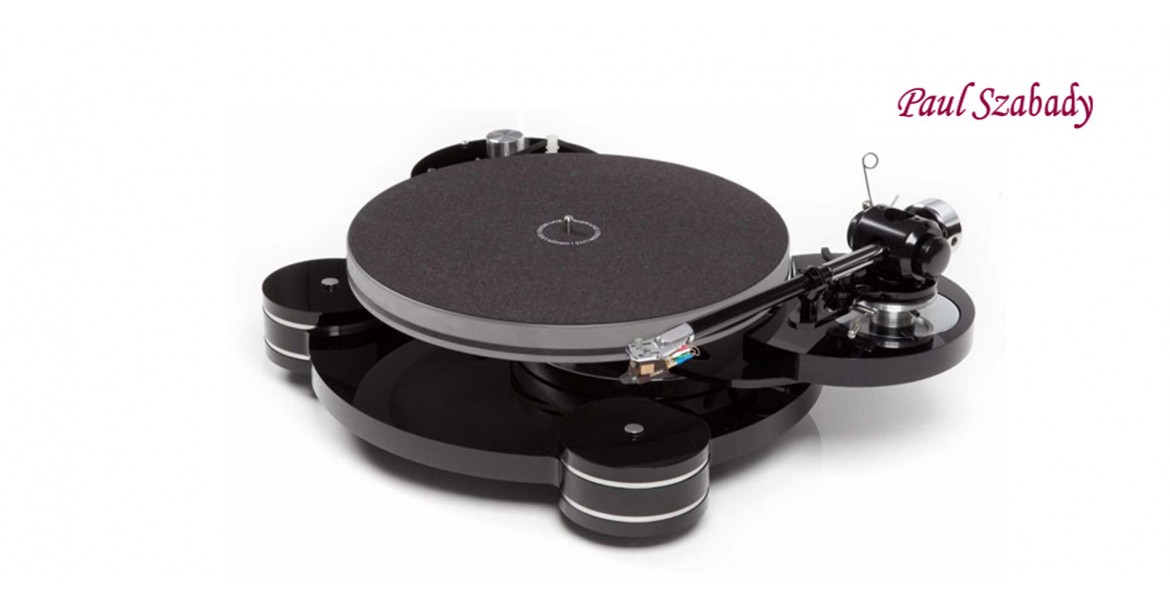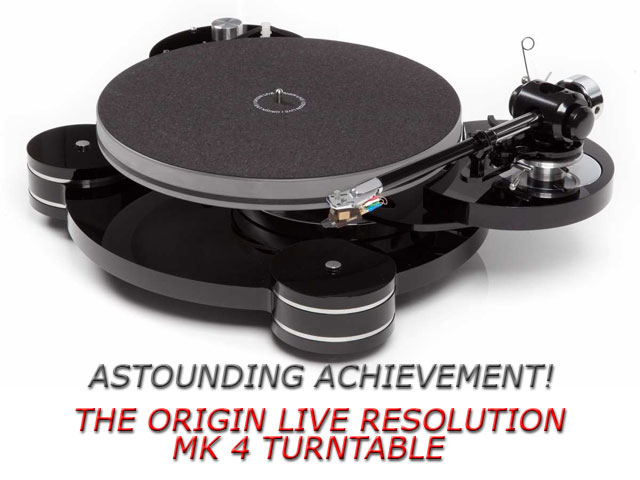
They had already bought up the original older US hi-fi firms (Marantz, Fisher, Scott, Sherwood, etc,) Anglicized their names (Pioneer, Kenwood, Technics) and then dominated the advertising in the US hi-fi print publications. By the decade’s end they had convinced the US mass market that Direct-Drive turntables were the only choice. Just think, you no longer had to replace a $2 belt every two to 5 years. You now had to replace the entire turntable if a servo or DC motor went sour. It was the UK’s Ivor Tiefenbrun, founder of Linn, who stripped the Emperor of his New Clothes. He used the simple expedient of listening.
He compared his belt-drive, suspended-subchassis, Linn Sondek LP12 turntable’s ability to play music to the then reigning direct-drive Panasonic (Technics) SP 10 at numerous hi-fi trade shows around the world. I caught 2 of his demos at the Chicago CES in the mid 1970’s. Seemingly iconoclastic and radical at the time, but brazenly common sense in retrospect, he asked listeners to choose which turntable played music better. Which table allowed one to identify a tune well enough to be able to sing or hum it, played tunes in the bass region, and depicted the rhythm so clearly that one had to tap one’s foot? The results were utterly clear.
The Linn LP12 made music; the Panasonic SP10 made sound and noise. I confirmed the experiment back home in my store, where the humble, cottage industry-vibe Sugden Connoisseur BD 1, mated to the Infinity Black Widow tonearm and G.A.S. Sleeping Beauty cartridge humiliated an SP 10/SME combination. Clearly the UK firms were onto something. The turntable did make a big difference in the reproduction of music. This realization inspired a flurry of turntable manufacturers in the UK, including Linn, Ariston, Fons, Rega, Roxsan, Systemdek, Michell, Pink Triangle, Townshend, Walker, and others.
They were largely mythical in the US due to basic lack of overseas distribution. The thinking behind this flowering of UK turntable design and manufacture was well articulated by the many think-piece articles in the UK printed Hi-Fi press in the 70’s. These articles clarified the details of just what exactly the front-end was trying to do –extract vibrations from the LP groove as small as a wave-length of light –while simultaneously trying to eliminate any spurious and non-music-related vibration. The emerging standard design formula used belt drive to isolate the motor’s vibration from the platter through the belt’s filtering ability, effective in most cases down to 5 Hz.
The AC synchronous motors, run at higher RPM (usually 300) and geared down by pulley to achieve 33.3 and 45 RPM, were controlled by the AC line frequency from the wall socket. Simple and elegant to be sure, but not really new, as the US’ Acoustic Research XA/XB tables had pioneered that path in the early 1960’s. Since the motor is the first input of unwanted vibration into any turntable system, the Direct-Drive motor, placed directly below the platter, and driving it by direct connection to the record spindle and platter, proved to be the perfect way to transmit that unwanted motor vibration to the record. These non-musical vibrations then went into the stylus, cartridge, and tonearm, seriously degrading the musical signal. Goodbye low-level detail and expressive subtle dynamic shifts. Hello transient slurring and homogenization. Added to the need to run the DD motor at exactly 33.33 RPM, which demanded a slow speed motor, the technical nightmare continued.
Ever try riding a bicycle at 1 mile per hour? You have to constantly alter pedal speed and balance to keep from falling over. The direct drive motors of the day not only cogged in their rotation but also needed a servo mechanism to try to maintain 33.33 RPM. Result: motors that were always changing their speed as the servo operated. Not only did the Emperor’s New Clothes not exist, the Emperor himself was dead. He certainly couldn’t dance. Consequently, I’ve been a keen observer and champion of the UK-school of turntable design and performance ethos: the music comes first. Watching designs develop over the past five decades has been an intriguing experience. The spring-suspended subchassis approach (Linn LP12, et. al.) presented difficulty in practical application, as varying the physical placement of the tables produced enormous changes in performance. At worst, placing the suspended tables on wooden floors of even the slightest sag could cause the arm to jump out of the groove.
The suspension simply didn’t work when confronted with the ultra-low frequencies of footfalls. The problem was exacerbated by placing the table on a high-mass support. I don’t suppose any nostalgia exists for the furtive and soft-footed sneaking up to the turntable that owners of sprung tables had to endure. At the other end of design spectrum was the ‘planar’ design popularized by the Rega Planar table of the mid-70’s.
Here the motor, platter bearing, arm, and platter were mounted on one solid plinth supported by elastomer feet. Simpler, cheaper, and much easier to successfully implement into the average room, variations of the ‘planar’ pattern paved the way for many future designs. By the early 80’s, the hierarchy of turntable purchase recommendations in the UK had solidified: a Dual belt-drive CS 505 for entry level, then the Rega Planar as one’s finances permitted, and ultimately the Linn Sondek LP12. This solidification took on the characteristics of rigid dogmatism in the UK, while the US went on, benighted and oblivious.
I vividly recall the sound of the Japan, Inc. DD tables of the time. Equipped with massive S-shaped tonearms that rang like gongs and bells (grossly mismatched in mass to the high compliance cartridges that ruled the day,) and loaded into the cheesy and easily overloaded phono stages of the average receiver, the result was a Rice Krispies symphony of “Snap, Crackle, and Pop” overlaying the harsh roar of incoherent mush.
The criminally low quality of US LP pressings of the time only exaggerated the cacophony. No wonder that the cassette was so popular, and that the US market ran like lemmings to the CD when it was introduced in the early 1980’s. The launch of the CD, with its Orwellian “1984” press propaganda and marketing hype, was one of the sleaziest attempts to brainwash consumers. It was incredibly successful in the US and created a crisis for turntable manufacturers, as it became clear that the CD wasn’t just another new alternative format: its goal was to kill the LP. The fact that the two developers of the CD – Philips and Sony – were also enormous record companies pointed to the corporate greed that reached Himalayan proportions. Not only was the CD far cheaper to manufacture than an analogue LP (No, there weren’t any jewels in the CD’s ‘jewel boxes’), but it also sold at exorbitant prices comparatively.
Enormous profits on new CD releases plus an entire back catalogue waiting to be re-released on CD let greed run wild. LP playback was painted as somehow Luddite, if not actively sinister and subversive, and eventually electronics manufacturers began to eliminate phono stages from their products. So you couldn’t play LP’s on the new ‘digital ready’ gear even if you wanted to. Still, the LP soldiered on in the US until the record companies delivered the coup de grace by eliminating the returns policy for defective LP pressings. This meant that record stores had to eat any defective LP’s that were returned by customers. Not surprisingly, new LP’s quickly disappeared from record stores. Turntable manufacturers were at a crossroads. Many, particularly in the mass-market, simply stopped production.
Others stalled their development of new products. The UK was quite different, however, as it was far slower to embrace the CD. Perhaps it was because UK LP pressings were better than the US equivalents, or perhaps it was because the average turntable used was better than the Direct-Drive drek that dominated the US. A landmark development in this time of uncertainty for the future of analogue LP was the visionary decision by Roy Gandy of Rega to invest heavily in new tooling to mass-produce the legendary Rega RB 300 tonearm. Here was an affordable tonearm that gave even the budget-constricted music lover a shot at high-resolution LP playback. It made the Jelco/Lustre OEM arm previously used on the Rega Planar 3 sound broken. Another key development was Arthur Khoubesserian’s Pink Triangle turntable: the first to use a DC motor to drive the belt and the first to use an acrylic platter. It knocked Linn off the top of the pyramid.
Max Townshend’s use of silicon–damping at the cartridge headshell on his Rock turntable’s arm and the release of his air-bladder Seismic Sink isolation platforms revealed that turntable/arm performance development was healthy, vigorous, and rigorous. One of the guiding principles of high-performance audio during the 90’s (refined and continued into the new Millennium) was the re-examination of all the ’givens’ in audio back to first principles. Everything, from the quality of the AC entering one’s house, to the connectors tying the system together, to the effect of placement of the gear in the room, was looked at (and spawned new products) in the quest to perfect the system’s performance.
Turntable development partly turned to questioning the reliability and accuracy of the AC line’s alternating current, which the AC synchronous motor depended on to give correct speed. The sharpest insights into the problem inspired new voices from the wilderness proclaiming that the box of orthodoxy was constricting true improvement in LP playback performance.
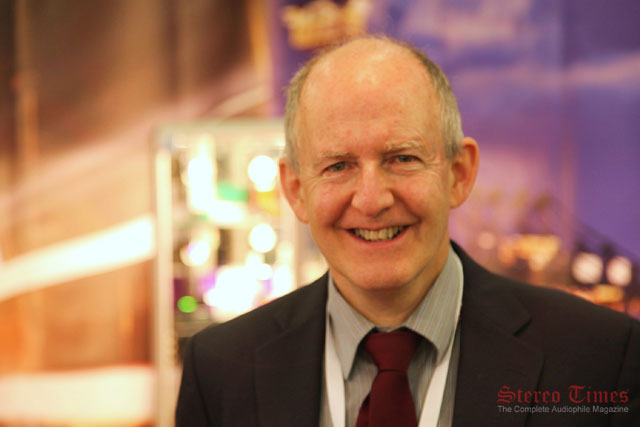
It seemed ludicrous to me to spend more on an electronic device to ensure that the AC motor was running optimally than the price of that motor itself, and with the more exotic products, more expensive than the total cost of my 2 used LP 12’s combined. Baker’s claims for the effects of OL’s DC-motor conversion were far exceeded in the musical and sonic results with my LP 12, spurring my further investigation into Origin Live’s products and Mark Baker’s fertile and productive thinking. This investigation led to the most musically satisfying LP playback experiences of my life. Origin Live is unique in that their products not only excel in ultra-fidelity, but are also ultra components in delivering music. Baker’s torrid creative design streak has continued throughout this millennium.
His current line of turntables and tonearms set the standard for Analogue LP playback. The Origin Live Resolution MK 4 turntable is a plateau product in Baker’s turntable line of 5 different decks. All OL’s tables use DC motors to drive their proprietary belts (see my “Spring Cleaning with Origin Live” ) The motor, electronics, and pulley are mounted in a round pod which is physically separated from the table itself.
The remote power supply is connected to this pod, which also contains the speed selector switch. All current OL tables include their Light Speed Control (LSC) system, which brings absolute speed stability down to 0.0001%, or, in other words, close to perfection. All the tables use an oil-bath bearing incorporating OL Platter Glide bearing oil, and feature acrylic-based platters topped by OL’s own thin platter mat. The tables are strikingly simple-looking and structurally skeletal, elegantly hinting at the sophistication and complex thinking behind their design and construction. The tables are supported by 3 adjustable feet.
One of these prophets was the UK’s Mark Baker, the founder of Origin Live (photo right ). One of Origin Live’s first products (and still available today) was a DC-motor conversion kit for originally AC-motored turntables. Indeed, my discovery of the firm originated when the Valhalla board on my Linn Sondek LP12 went up in smoke. The Valhalla controlled the speed of the LP12’s AC motor, and Linn, along with other manufacturers, were developing more and more complex and highly priced solutions to give the AC motors a pure 50 Hz (60 Hz for the US) signal. It seemed ludicrous to me to spend more on an electronic device to ensure that the AC motor was running optimally than the price of that motor itself, and with the more exotic products, more expensive than the total cost of my 2 used LP 12’s combined.Baker’s claims for the effects of OL’s DC-motor conversion were far exceeded in the musical and sonic results with my LP 12, spurring my further investigation into Origin Live’s products and Mark Baker’s fertile and productive thinking. This investigation led to the most musically satisfying LP playback experiences of my life. Origin Live is unique in that their products not only excel in ultra-fidelity, but are also ultra components in delivering music. Baker’s torrid creative design streak has continued throughout this millennium. His current line of turntables and tonearms set the standard for Analogue LP playback.
The Origin Live Resolution MK 4 turntable is a plateau product in Baker’s turntable line of 5 different decks. All OL’s tables use DC motors to drive their proprietary belts (see my “Spring Cleaning with Origin Live” ) The motor, electronics, and pulley are mounted in a round pod which is physically separated from the table itself. The remote power supply is connected to this pod, which also contains the speed selector switch.
All current OL tables include their Light Speed Control (LSC) system, which brings absolute speed stability down to 0.0001%, or, in other words, close to perfection. All the tables use an oil-bath bearing incorporating OL Platter Glide bearing oil, and feature acrylic-based platters topped by OL’s own thin platter mat. The tables are strikingly simple-looking and structurally skeletal, elegantly hinting at the sophistication and complex thinking behind their design and construction. The tables are supported by 3 adjustable feet.
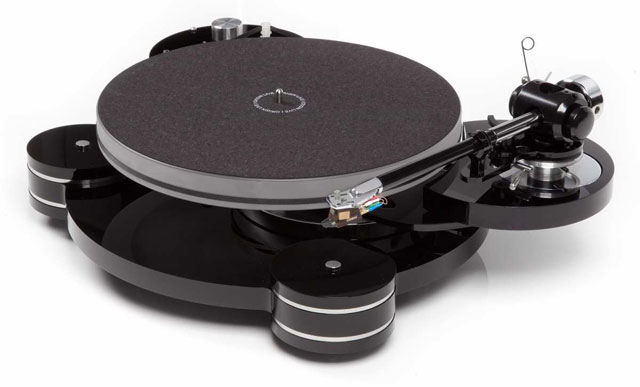
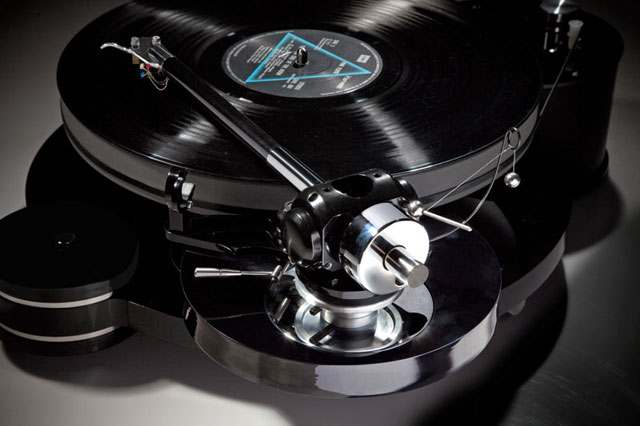
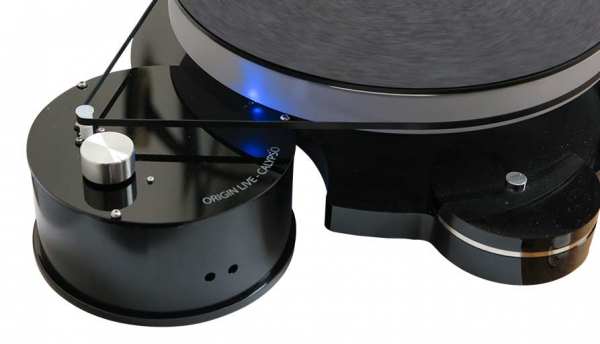
Origin Live claims an absolute speed stability of 0.0001% with the Light Speed Controller (LSC) and it certainly sounds like it. The physical placement of instruments, their pitch, transient response, and note decay is absolutely superlative. Those unfortunate listeners with perfect pitch will be both dazzled and completely satisfied. The Resolution 4’s speed accuracy allows rhythm, pulse, and timing to be depicted unambiguously. Assuming a concentric record hole on a given LP pressing, any flubs in timing and rhythm can now be attributed to the performers themselves rather than to the turntable. I find the Light Speed Control system on Origin Live’s line of tables a genuine advancement of the state-of-the-art.
Since the motor pod is completely isolated from the turntable itself, any chance of the motor producing non-musical vibrations into the cartridge’s stylus is effectively nullified. Only the belt touches the platter, and even 1970’s-era belt drives could filter mechanical vibrations down to 5Hz. OL’s proprietary drive belts (also offered for a variety of other tables) are probably the best single inexpensive improvement one can make to an existing table.
The Resolution MK4’s platter bearing is de-coupled from the subchassis, as is the record spindle from the platter itself. The bearing runs on OL’s Platter Glide bearing oil. I opted for OL’s multi-layer platter option, which, though relatively expensive at 960 UK Pounds (US$ 1230), raises the Resolution’s performance high enough to rival OL’s more expensive Sovereign table. The Resolution MK 4 is thus the result of a long line of continuous development and critical and creative engineering thinking from Mark Baker. I don’t think anyone is more skilled and experienced in applying coupling and de-coupling, the sonic attributes of various materials and metals and their combinations, and overall design intelligence. Moreover he seems to be unencumbered by orthodoxy and dogma.
As I’ve stated before, my near 20 year experience with Origin Live products have been the most musically rewarding and aesthetically satisfying of my 60 year history listening to LP playback. Still, I was intensely surprised at the improvement shown by the Resolution MK 4 when I inserted it into my system. Now none of the 8 turntables/arms in my analogue stable are in any way slackers either musically or sonically, but it was immediately clear that the Resolution MK4 was operating on a much higher plane: it was more neutral, more natural, more accurate, more transparent, and more literal. In short, the highest fidelity to music I’ve heard from any turntable.

Recording venue depiction was equally literal, the sense of its air, height, and depth so convincingly natural that no mental energy was wasted in orienting oneself to the recording’s ambience. But what happened in that venue was, obviously, far more important. Instrument placement and the sound stage formed by that placement were so literal and so accurate that they were only limited by the microphone placement at the venue site, and by the quality and aesthetics of the recording engineers’ production values.
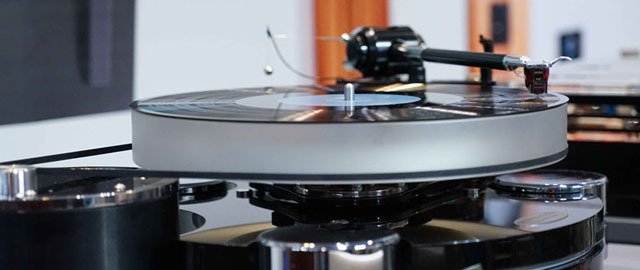
Analogue music reproduction is capable of infinite resolution, but Analogue LP playback faces a variety of obfuscating mechanical physical resonances that are extremely difficult to completely eliminate. There is something deeply heroic about designers who continue to pursue perfection in a medium that might be ultimately imperfectable. This undaunted idealism has resulted in new analogue products that have raised Analogue LP performance in the last twenty years to quality levels that are more like quantum leaps than subtle refinements. And the gap between Analogue LP and Digital playback just gets wider and wider. Listening to music with the Resolution, Enterprise, MusicMaster and Accession was almost disquieting in its natural-ness and musical communication. Indeed, I immediately started listening to music the way one does in a live performance. One’s attention was no longer focused on hi-fi artifacts, but purely upon the music itself.
Analogue LP playback has always excelled at low-level detail and resolution, the kind of detail that allows one to hear the quality of the musician’s performing art. Rhythm, inflection, dynamic variation, and emotional expressiveness were so complete and natural with this combination that the aesthetic value of a performance and the artistic meaning of a given piece of music were completely available to perception. Artistic distortion was the lowest I’ve ever heard from a hi-fi system. The Resolution MK4-based front end achieves this level of artistic clarity through the combination of first-rate timbral and transient accuracy, literal and supple depiction of rhythm, dynamic variation, and timing, and by the ability to completely differentiate all the instruments that are playing.
The instruments are not only physically separated in space, but the integrity of their individual sonics is maintained no matter how complex or dynamic the scoring. This ability to keep both the individual trees and the forest always in complete focus is also the best I’ve ever heard. I have to admit to being “Wow”-ed speechless by the Resolution MK4. It strikes me as a state-of-the art masterpiece of turntable design. It reaches a level of neutrality, fidelity, and musical communication from analogue LP that transcends the format’s formidable challenges and fully reveals its music-making emotional and artistic wallop. I’d casually assumed that the name “Origin Live” was a metaphoric ideal to be strived for, but perhaps never to be achieved.
But when I found myself experiencing music through a hi-fi system the same way I experience it live, and with the same aesthetic intensity, the significance of Mark Baker’s achievement with the Resolution MK4 turntable and the Enterprise C tonearm crystallized. “Origin Live” can be understood literally. Congratulations and deep thanks to Mark Baker for this astounding achievement, and for his service to music lovers everywhere.


Buy it Now
https://www.chameleonracks.gr/Origin%20Live%20turntables/Resolution-en

